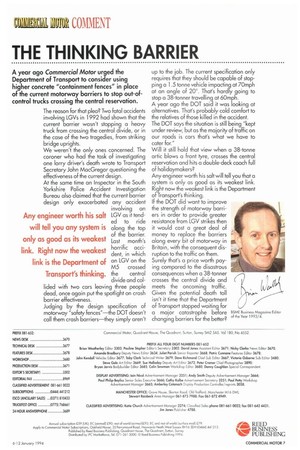THE THINKING BARRIER
Page 9

If you've noticed an error in this article please click here to report it so we can fix it.
A year ago Commercial Motor urged the Department of Transport to consider using higher concrete "containment fences" in place of the current motorway barriers to stop out-ofcontrol trucks crossing the central reservation.
The reason for that plea? Two fatal accidents involving LGVs in 1992 had shown that the current barrier wasn't stopping a heavy truck from crossing the central divide, or in the case of the two tragedies, from striking bridge uprights. We weren't the only ones concerned. The coroner who had the task of investigating one lorry driver's death wrote to Transport Secretary John MacGregor questioning the effectiveness of the current design.
At the same time an inspector in the South Yorkshire Police Accident Investigation Bureau also claimed that the current barrier design only exacerbated any accident involving an LGV as it tended to ride along the top of the barrier. Last month's horrific accident, in which an LGV on the M5 crossed the central divide and col lided with two cars leaving three people dead, once again put the spotlight on crash barrier effectiveness.
Judging by the design specification of motorway "safety fences"—the DOT doesn't call them crash barriers—they simply aren't up to the job. The current specification only requires that they should be capable of stop ping a 1.5 tonne vehicle impacting at 70mph at an angle of 200. That's hardly going to stop a 38-tonner travelling at 60mph. A year ago the DOT said it was looking at alternatives. That's probably cold comfort to the relatives of those killed in the accident.
The DOT says the situation is still being "kept under review, but as the majority of traffic on our roads is cars that's what we have to cater for."
Will it still hold that view when a 38-tonne artic blows a front tyre, crosses the central reservation and hits a double-deck coach full of holidaymakers?
Any engineer worth his salt will tell you that a system is only as good as its weakest link.
Right now the weakest link is the Department of Transport's thinking. If the DOT did want to imorove the strength of motorway Darriers in order to provide greater resistance from LGV strikes then it would cost a great deal of money to replace the barriers a ong every bit of motorway in Britain, with the consequent disruption to the traffic on them. Surely that's a price worth paying compared to the disastrous consequences when a 38-tonner crosses the central divide and meets the oncoming traffic. Given the potential death toll isn't it time that the Department of Transport stopped waiting for a major catastrophe before changing barriers for the better?








































































